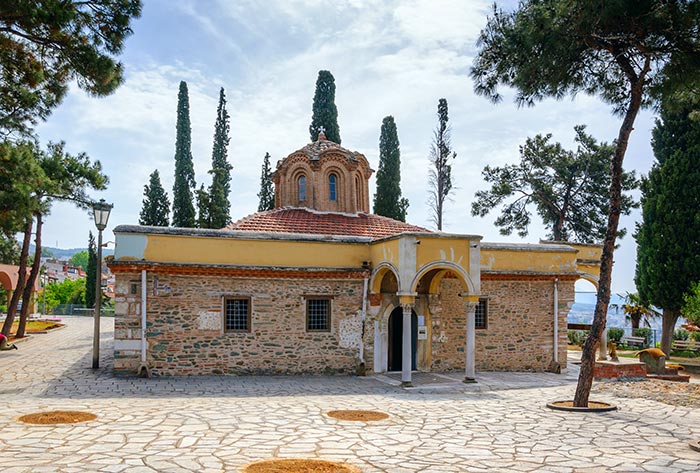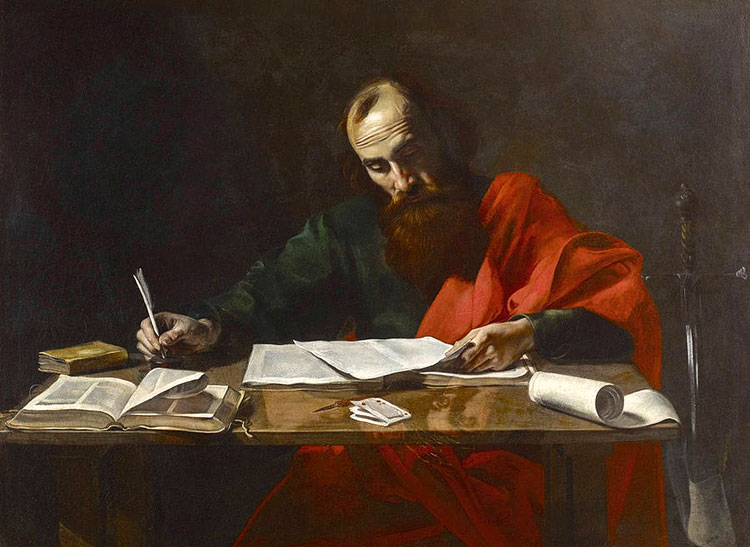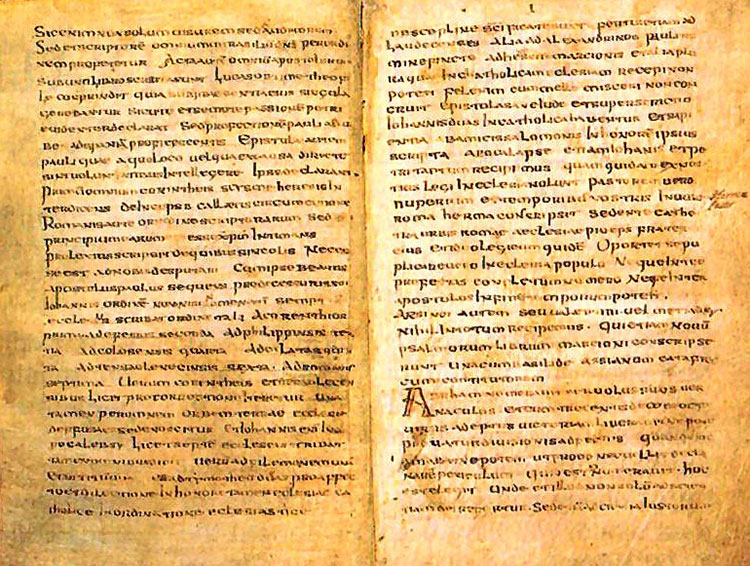
Apostle Paul Life, Teaching & Theology
Paul’s Epistles to Thessalonians: "Jesus is the Messiah"
The First Letter of St. Paul to the Thessalonians is considered one of Paul's earliest epistles, likely the first written letter of the New Testament of the Bible. In order of appearance, 1 Thessalonians is preceded by Paul's Letter to the Colossians and followed by his Second Letter to the Thessalonians. From the letter itself (3:1-6), and the record of Paul's travels in Acts (Ac 17:10-18:11), it seems that Paul wrote this letter soon after arriving in Corinth on his second missionary journey, while the exact date of both the Thessalonian Letters has been accurate and is considered to be and was composed around 52 - 53 AD.
To be précised, the writing of 2 Thessalonians was not long after 1 Thessalonians because it did not achieve all that Paul had hoped it would, while he had become aware of new problems too. Many scholars believe 2 Thessalonians was written about six months after 1 Thessalonians. This would place the writing of the second epistle during Paul's extended 18-months-stay at Corinth on his second missionary journey (cf. Ac 18:1-11), sometime around 53 A.D.
What are the events surrounding both the Thessalonian letters?
The events that led to Paul's writing of the Thessalonian letters are complex and interlinked, but there are certain differences between the two letters regarding the external circumstances and the emotional setting in which Paul was in to.
Paul was forced to leave the new Thessalonian believers at a crucial time, because the Jews had incited the superstitious, polytheistic rabble of the city to riot at Jason's house in a search for Paul and his companions. He, therefore, went to Berea with Timothy and Silas, where he received a true support by the Jews there. However, the Jews from Thessalonica came down to Berea and started causing trouble. Therefore, Paul had to leave again and headed to Athens. When Paul went to Athens, he received a cold and unresponsive welcome. When Timothy joined Paul at Athens (cf. Ac17:14-16), his concern prompted Paul to send Timothy at once back to Thessalonica to encourage and ground the new disciples in the faith, and to learn how they were enduring persecution (cf. 3:1-5).

Could a church be founded in such a short time and in difficult circumstances still endure?
Many think Timothy stayed and ministered there for six months to a year, as the church desperately needed someone to act as an inspired leader. Timothy himself was a fairly new convert, while his teaching in the new Macedonian Church was Timothy's first assignment as Paul's official representative. In this emotional state of anxiety and agony for the new believers, while also disappointment for his visit in Athens we found Paul as he arrived in Corinth.
When Timothy returned to Paul in Corinth (cf. Ac 18:5), the news was mostly encouraging (cf. 3:6-7). Despite persecution they had remained strong (2:13-16), and even proved themselves to be an example to others (1:6-8). It was Timothy's message from Thessalonica that would lead Paul to write to them from Corinth, responding to questions related to the church on doctrinal and practical issues. Especially, Paul in his first letter to Thessalonians, decided to write some words for boosting their stead behavior they showed under persecution, for further instruction concerning holy living (cf. 4:1-12) and also for reassuring that their loved ones who died in Christ would not miss out on the blessings involving the coming of our Lord (cf. 4:13-18).
The First Epistle to Thessalonians (1 Thessalonias)
At first, Paul congratulates the Thessalonians on their fidelity to the gospel that he had showed and urges them to remain steadfast in the faith. Paul's express his great affection for the Thessalonians who became "imitators" of Paul (1:6-7) and they turned from "idols" to serve God. Paul speaks of how much he cares and worries for them and their Christian faith in light of their persecution and suffering. He describes himself as the spiritual mother and father of the Thessalonians and names them as his spiritual children (chapters 1-3); He also warns them to walk in holiness by abstaining from sexual immorality (4:3-8) and against various forms of self-seeking, which are contrary to the spirit of the Christian way of life, to walk in love (4:9-10), walk in diligence (4:11-12), walk in hope (4:13-18), walk in obedience (5:12-22).
Above all, this epistle is unique in the way that every chapter ends with a reference to the second coming of Christ (1:10; 2:19; 3:13; 4:13-18; 5:23). "And may the Lord make you increase and abound in love to one another and to all, just as we do to you, so that He may establish your hearts blameless in holiness before our God and Father at the coming of our Lord Jesus Christ with all His saints." This is also, the main purpose of Paul's letter as he shared with the Christians at Thessalonica his belief that the end of the age would come in the very near future. This common belief among the early Christians and Paul is partly an inheritance from Jewish apocalypticism held that the messianic kingdom would be ushered in by a sudden catastrophic event. Although the Christians were quite insistent that no one knew the exact time when this second coming would take place, they felt sure that it would occur during the lifetime of those who were then members of the Christian community. It seems reasonable though, that this eschatological element of Paul's preaching aroused questions in the minds of the immature Thessalonian Christians: What would happen to believers who had died before the Lord's return? What would happen to the believers in the congregation who had stopped working and were sitting around waiting for the Lord's return?
An explanation was in order, and this situation, more than any other single factor, was the reason of Paul's First Epistle to the Thessalonians writing. Paul supports that he has in no way abandoned his faith that the return of Jesus to this earth will take place in the near future. As for those who died or who might die before Jesus returns, he explains that both the living and the dead will share in the resurrection (4:15-18). "For the Lord himself will come down from heaven, with a loud command, with the voice of the archangel and with the trumpet call of God, and the dead in Christ will rise first." To this statement, Paul adds, "After that, we who are still alive and are left will be caught up together with them in the clouds to meet the Lord in the air. And so we will be with the Lord forever." In addition, Paul urges the new believers to go on working quietly, to walk in light (5:1-11) while waiting in hope for the return of Christ, “For the Day of the Lord will come as a thief in the night” (5:1-4).

The Second Epistle to Thessalonians (2 Thessalonias)
Paul's Second Epistle to the Thessalonians is in one sense a follow-up to the first letter that was well received, adding a more apocalyptic nature, as he describes the events that will take place before the Parousia, the Second Coming of the Lord. In that, after commending the Thessalonians for their loyalty and strength despite persecution, and assuring them that God will deal justly with their persecutors (cf. 1:3-4), Paul proceeds to the main intention of the letter. Believers were satisfied with Paul's explanation concerning those who died and were ready and willing to suffer persecution if needed in order to remain devoted to the gospel that Paul preached, in the first epistle. However, some members of the Christian community were so overly zealous about Paul's teaching that the end of the age was near at hand that they stopped making any work at all or any plans for the future. This dichotomy to those who did not work and to those who did work, created a new problem for the Church.
Also, from the inference of 2:1–2, the Thessalonians were faced with a false teaching, saying that Christ had already returned. Paul tells the Thessalonians that a great tribulation must occur before Christ's return (2:1–12). He then expresses thanks that his readers were the elect of God, chosen for salvation and saved by His grace through faith, and thus not susceptible to the deception of the "Great Apostasy" (2 Thess 2:13–14). He states that this great tribulation has to do with the coming of an Antichrist, someone in whom the power of Satan has become incarnate and who will establish himself in the Temple at Jerusalem, working with signs and wonders to deceive people. It is important to underline that the "son of perdition" or "the lawless one," is also being refered in the Gospel of John 17:12 and the Book of Revelation. The basis for Paul's statement along this line is found in the Jewish apocalyptic writings, which he was pretty aware of. He supports that the Antichrist's activities are already in operation and would be carried out more fully except that he is now being restrained (it is thought that, Paul means that the Roman government is restraining the Antichrist). In due time, the Antichrist will be revealed, and "the Lord Jesus will overthrow with the breath of his mouth and destroy by the splendor of his coming." The letter closes with a warning to the Thessalonians to continue their regular lines of work and not to wait apathetic in idleness for the return of Jesus.
What else is to be learned?
Both the Thessalonian letters provide important insight into Paul as both missionary and pastor, his own way of ministry and his relations with the newly formed Christian communities. Paul addressees to Gentiles of a pagan religious background (“you turned to God from idols” 1:9-10), while he introduce us with an early Christian practice known as the “holy kiss” (1: 5:26) a greeting shared among Christians as a sign of their fellowship at their meetings. Moreover, Paul instructs his readers to "hold fast to the traditions which you were taught, whether by word of mouth or by our letter." (2: 2:15) and to "keep away from every brother who leads an unruly life and not according to the tradition which you received from us… do not associate with him, so that he will be put to shame. Yet do not regard him as an enemy, but admonish him as a brother" (2: 3:6–7, 14–15). It is believed by scholars that Paul's reference to tradition implicates that was delivered from the Lord and called the "apostolic' tradition". At that time, the oral tradition has been defined as the "tradition" and the written tradition as "Scripture", united together in "the authenticity of their apostolic origin". Cyril of Jerusalem in his Catechetical Lectures, argues that the traditions stated by Paul should be preserved and memorized, at a minimum in the form of the Creed.

Was Paul the real writer of the letters?
Only modern form critics of scholars in the mid-19th century have seriously doubted the Paul's authorship and the authenticity of 1 Thessalonians, but their conclusions have not convinced many scholars. 1 Thessalonians is included in Marcion's canon (140 A.D.) and in the Muratorian Fragment (200 A.D.). Both lists of canonical books of the New Testament circulated in Rome, while Irenaeus quoted 1 Thessalonians by name around 180 A.D.
The 2 Thessalonians has not always been accepted as Pauline even though Polycarp, Ignatius, and Justin recognized it, the Marcionite canon and the Muratorian Fragment included it, while Irenaeus quoted it by name. The epistle has been attacked on several grounds, such as the total structure of the two letters which is different from what is taken to be the standard Pauline form, the different vocabulary or the too formal style of the letter - less intimate that the 1 Thessalonians, while some of scholars support that the theology of the two letters is supposedly inconsistent.
Scholars who support its authenticity view 2 Thessalonians as having been written around 51–52 AD, shortly after the First Epistle. Those who see it as a later composition, assign a date of around 80–115 AD. The famous scholar Brown believes that the majority of scholars who advocate pseudonymity would place it towards the end of the first century, the same time that Revelation was written. These scholars emphasize the appearance of "man of sin" in the second chapter of this letter, whether this personage is identified with the Antichrist of 1 John and Revelation, or with a historical person like Caligula.
Other scholars have developed complicated theories involving redaction and interpolation in 1 and 2 Thessalonians, while another hypothesis is that the order of the epistles is reversed.
In fact, those who oppose authenticity have not succeeded in explaining the origin of the letter by a pseudonymous author, if it comes from one later period or another. The two letters compared are very similar, not only in ideas, but also in actual phraseology. Even if the general tone of 2 Thessalonians is different from the first letter, being less intimate and more formal, yet this can easily be understood when one sees the emotional circumstances involved in the writing of the first letter and the developed problems of the second letter.


